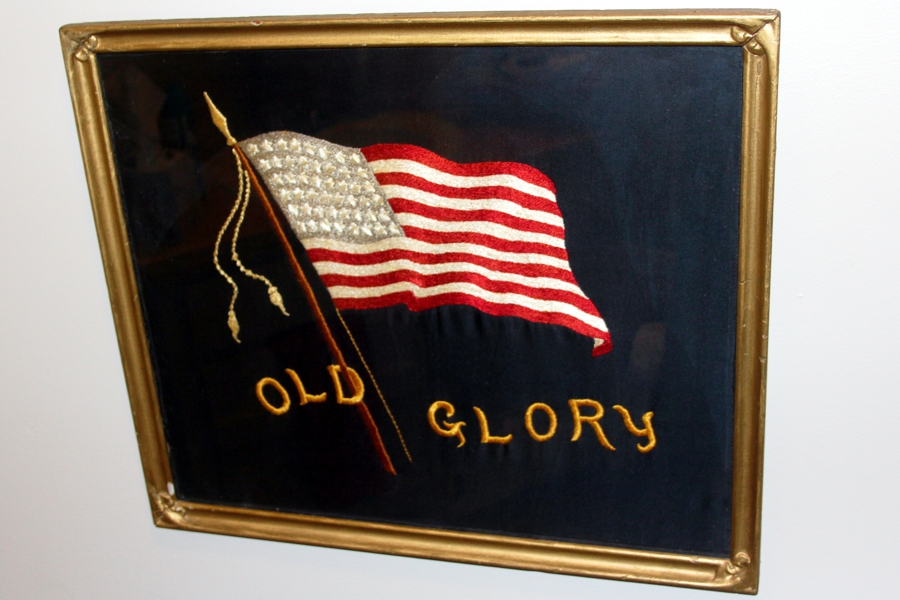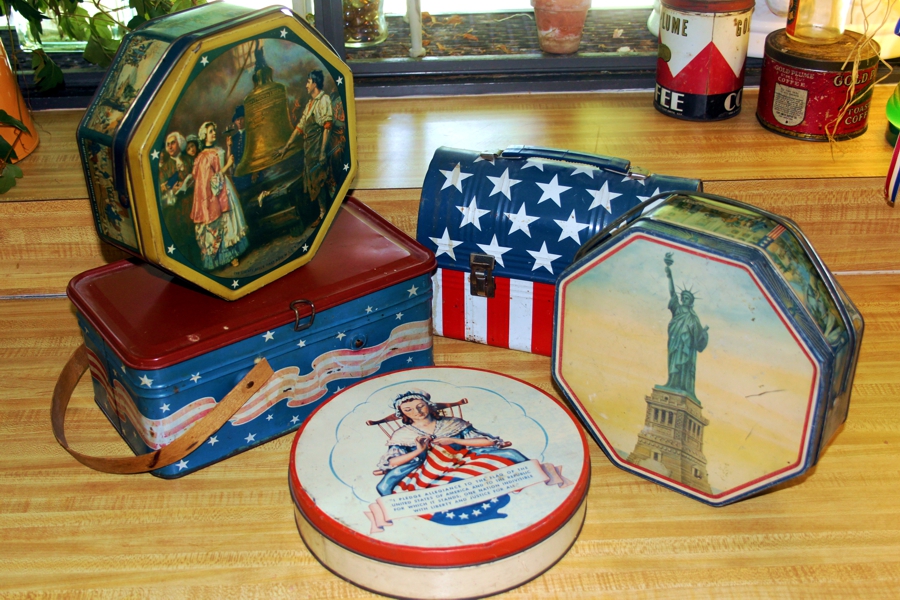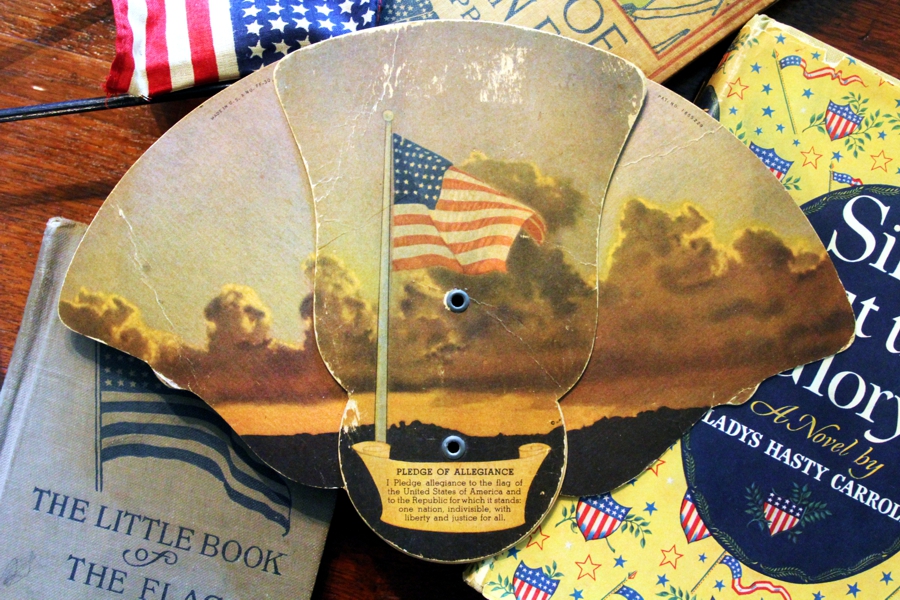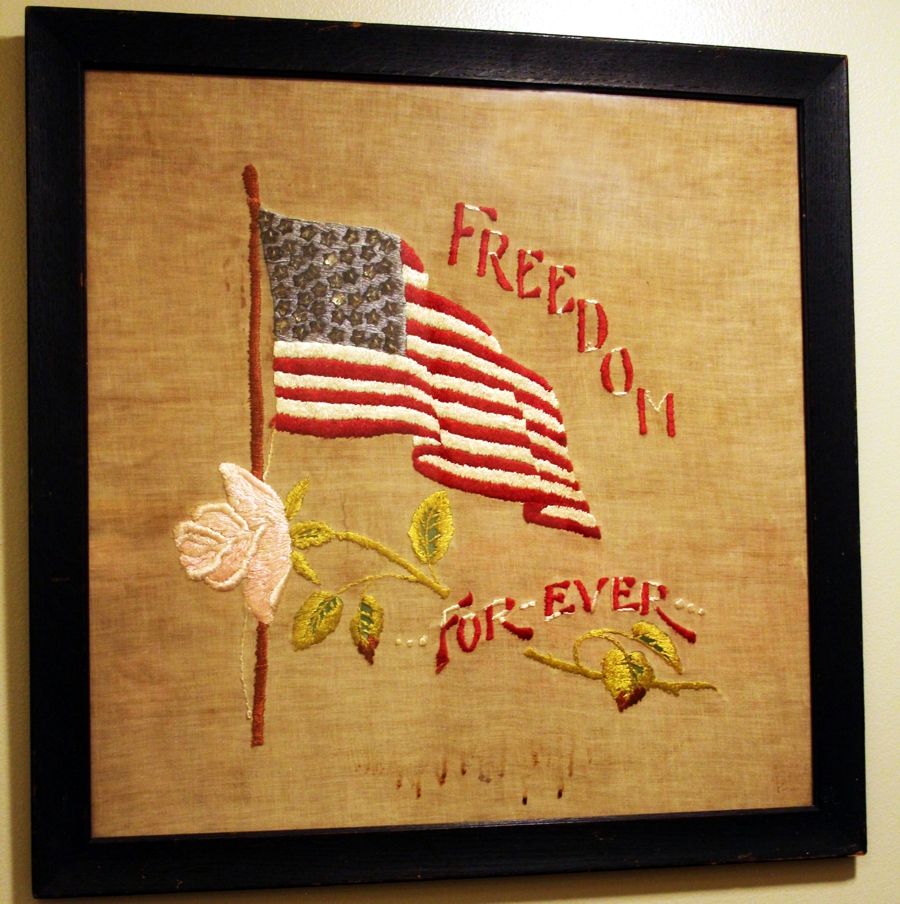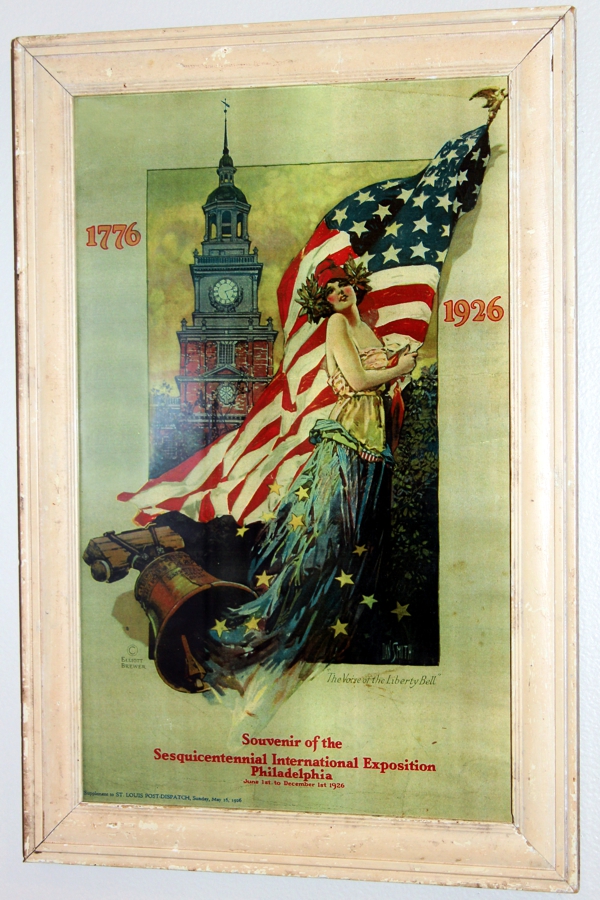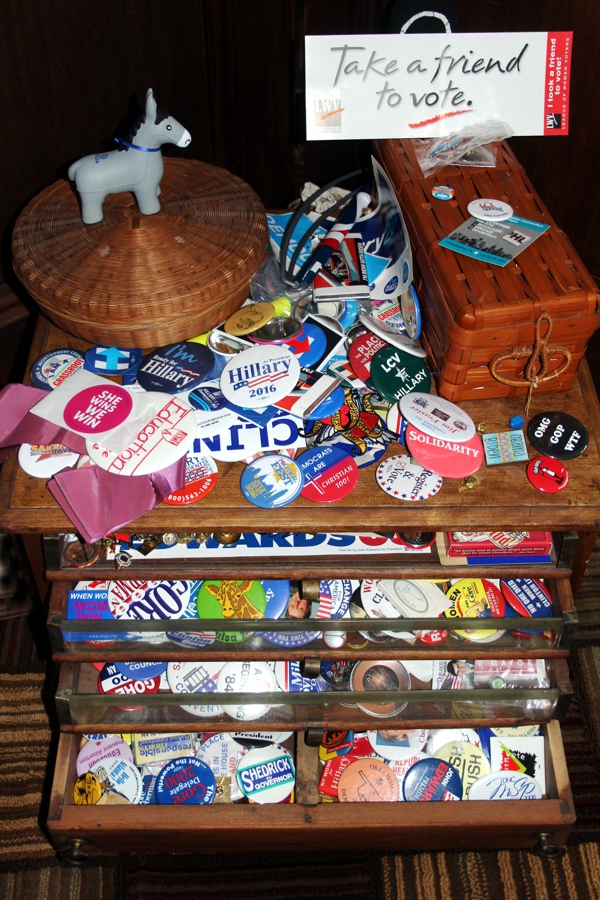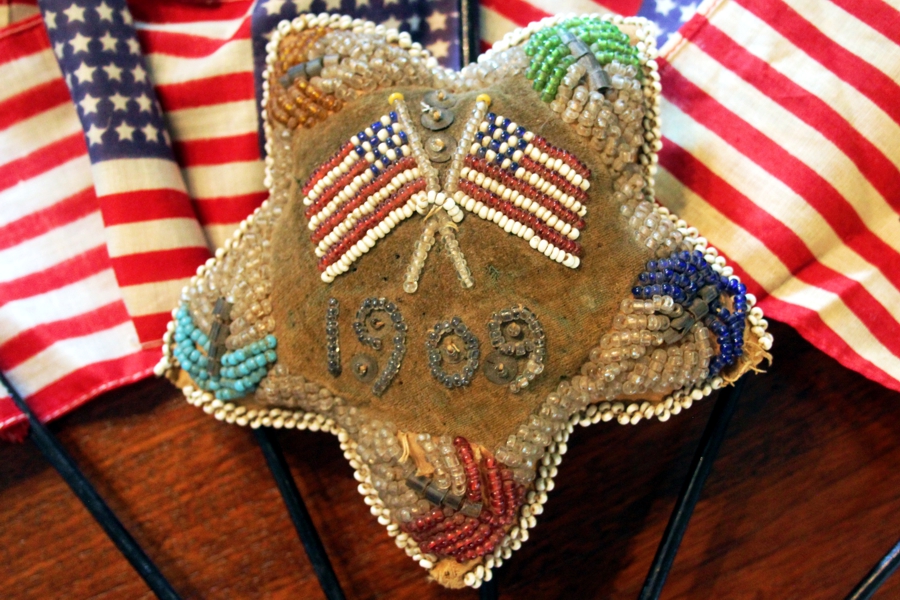Fun Info
“Fun Info” is our revolving door of interesting facts, stories, and anecdotes surrounding the countless items you may encounter while ambling through a local estate sale.
Because no estate sale is like another, you never know when you’re going to run across the ‘conversation piece’ of your dreams, the perfect table for that empty corner, or a stunning, one-of-a-kind necklace. The more knowledgeable you are going in, the smarter you’ll be in choosing an item that’s useful, fun, or worth cherishing.
“Fun Info” aims to provide a glimpse into the history of just a few of those yet to be discovered treasures we hope you find.
From time to time, we’ll also bring you the personal perspectives of collectors, valuable pointers from local experts in particular fields of interest, and helpful articles. If you have some fun info to share about collecting, we’d love to hear from you.
Patriotic Americana Collecting
It began with happy childhood memories of the 4th of July in Arkansas, where a Tulsa collector went with her family to creeks or lakes, enjoying watermelon, homemade ice cream, and fireworks. Independence Day has remained her favorite holiday since, and those memories – along with her passion for our country and interest in politics – inspired an exceptional collection of patriotic and political Americana.
She began collecting in 1966, when her husband was in the U.S. Navy JAG Corps, stationed in Jacksonville, Florida. As they moved or vacationed around the country, she found treasures in antique stores, estate sales, and flea markets. She says she recognized at the time, and especially now, that most were real bargains.
Some of the collection is displayed in her home, including a wool 48-star flag (shown above, top row, middle) and other beautiful handcrafted textiles, photos, books, flag holders, posters, patriotic ephemera, a sewing chest full of political buttons, flag memorabilia, and more.
Two personal favorites: a beaded pin cushion featuring two flags, dated 1909, and a flag-themed miniature umbrella with bamboo handle (see images below).
She’s not alone in her passion for patriotic/political memorabilia. The American Political Items Association http://www.apic.us/ now has more than 2000 members. Rare flags and other antique items such as flag bearers, eagle sculpture, banners, posters, buttons, and more often bring high prices at auction and online sites.
And many Americans love placing patriotic items as home décor, from pillows to bedding to placing large vintage flags as a focal point in rooms, much like a work of art.
So if you see a quality patriotic or political item you fancy, snap it up – it isn’t that easy to find. Stars and Stripes Forever!
What's This?
Stoneware, which came on the American scene around 1720 in Philadelphia and called the "poor man's porcelain," was the predominant houseware in the 19th century. It is heavy, dense, non-porous, and practically indestructible. This highly collectible, vintage ‘diner’ china was produced by several companies for personal as well as commercial use, most notably restaurants, railroads, cruise ships, and as shown in the photo, the U.S. Forest Service (Buffalo China ca. 1940s). These cups are as rock-solid as our reputation for conducting quality estate sales and personal property appraisals.
This is an egg scale from the early 1900s. As chicken and egg production became more systemized, hatcheries began to use “egg graders,” which calculated the weight of a single egg.
The demand for these gadgets grew during World War I, when the price The War Department paid depended on an egg’s size. Chicken growers also learned they could get premium prices at their local grocery for pre-graded eggs. WWII expanded the demand, with most of these devices produced from the early 1920s through 1940s. This particular model is a 1920s Zenith Pedigree Scale, 8 ½ inches tall, made in New York of cast iron and aluminum. Estate sales are a great place to find fun vintage kitchen gadgets like this one.
This is an 1890 EAPG (Early American Pattern Glass) pedestal banana stand in the “Crystal Wedding” pattern. The stand looks somewhat like a cake stand, with two sides folded up in a u-shape. EAPG, aka “pressed glass,” was made by American glass companies during the Victorian period, circa 1850-1910.
What about in 2017? Not just for bananas! Great for cutlery, napkins or breadsticks at your next party, hand towels or soaps in your bathroom, or holiday decorations any time of year. It’s entertaining to mix older glass with your contemporary faves. Fun finds such as this are just one of the reasons why it pays in many ways to shop estate sales. Silvey Estate Sales will go bananas if you like our page and sign up for our email list.
Santa Girl, Candy Barnard, Knows a Thing or Two About Ol' Saint Nick
When one meets Candy Barnard, it’s easy to see why she loves Santa Claus: they share the same cheerful, kind, and generous spirit. The Okmulgee collector and connoisseur of all things Saint Nicholas is a musician by profession – she taught music in public schools for more than 40 years and tutors students privately in voice, piano, guitar, and violin. When not making music, she’s known by many as “Santa Girl,” the user name she chose when she began buying and selling Santas on eBay 19 years ago. Santa collectors from far and wide consult her for the knowledge and experience she’s gained over many years pursuing a happy hobby indeed. We were delighted when Candy generously agreed to be interviewed about her collection for our website.
Tell us when and how your Santa collection began?
It began the first Christmas after the death of my father in 1990. My sister gave me a perfect 1950s Santa Glo flocked Santa, just like the one we had as children. I realized later that Santa reminds me of my father, who was the ultimate giver.
What captivates you about Santa?
He embodies everything wonderful and jubilant about the spirit of giving.
How large is your collection?
Without an exact count, I believed I’ve pared down to around 800.
Where have you made most of your great finds?
I love the hands-on hunt! My favorite places to find the jolly treasures are antique malls and flea markets.
Is there a particular era for Santa Claus that you love most, such as the 50s or 60s?
Since I was born in the 50s, I love mid-century Santas more than others, but I do tend to gravitate toward designer creations.
1951 Econolite Santa Lamp, private collection, purchased from Candy Barnard
Tell us about what you consider some of the choicest pieces in your collection.
Last year, I acquired a pink Harold Gale mechanical waving Santa. He’s four feet tall, and I’ve never seen another like him. I also have some beautiful Lladro pieces produced in Spain. I’m partial to my “Santa Calls” cookie jars, figurines, and books. The William Joyce book character came to life through the three jars, dolls, and ornaments.
What do you consider your most exciting Santa find ever?
I was shopping at the Tulsa Flea Market and spotted a large, gorgeous Ino Schaller Belsnickle (Germany) candy container. I was almost certain my pocketbook would have zipped itself and jumped from my bag to safer ground, but it came home with me. The seller said she just wanted to purchase new décor!
Ino Schaller Belsnickle candy container, pictured left
Is there a Santa you’re still on the search for?
I do so much research on line that there are always one or two I’d like to add to my collection. For now, I’m satisfied… mostly.
You keep the collection up year-round. What do your family and friends think of that?
I’ve been known to have “Claus-trophobia.” Many relate my collecting to an illness. I get it – it’s okay! My husband is very tolerant.
You sell Santas at times, but are there those with which you’re absolutely unwilling to part?
I will not sell gifts, and I’d never sell Santas that my husband and I have found together while on vacations. I’ve sold some really choice Santa Clauses in the past. I don’t recommend it.
Tell us about the Santa Collectors group you started on line.
I always wanted to start a local Santa Club that perhaps would meet once a month for lunch and share. Complicated, busy lives prevented such interest. Then Facebook groups came along and I thought I’d try it. We now have 180 members. We share pictures, stories, sales, etc., and we also make new friendships.
What is your opinion of the majority of Santa Clauses on store shelves today?
I’m not a fan of the quality of most of the new Santas. It’s difficult to find any that would stand the test of time. I do believe that one could purchase a new Santa at Neiman Marcus, for example, and be perfectly happy, but not everyone can spend that kind of money for a Mackenzie Childs Santa Claus.
"A Long Christmas Night," by Lladro, porcelain
What’s the best way for an aspiring collector to learn about collecting Santas?
There are many books for collectors, but people must realize that the secondary market prices will not be the value of the pieces in todays soft market. That being said, I advise people to just collect what inspires you and makes you smile! Vintage doesn’t have to be perfect; excellent will do. eBay is a good source for comparison. And now, you can buy and sell on Facebook without all the fees.
Candy, may people contact you personally with questions about Santas?
Yes, via email: siticandy@me.com. It would be my pleasure!
Humpty Dumpty Santa, unmarked, private collection, purchased from Candy Barnard
Vintage Halloween Collecting: It Can Be Spookily Addictive
“I'm so glad I live in a world where there are Octobers,” wrote Lucy Maud Montgomery, in Anne of Green Gables. And many of us share her enthusiasm for our tenth month and the gifts it bestows. According to at least one poll, a majority of Americans are happier to see the arrival of this season than any other. A survey by YouGov.com https://today.yougov.com/ found that 29 percent of respondents consider fall their favorite time of year, narrowly edging out spring. What’s not to love about it, with mild to crisp temperatures, dazzling foliage, cozy sweaters, kid pictures at the Pumpkin Patch, and of course Halloween, now the nation’s second favorite holiday, behind Christmas.
The Tulsa area is especially beautiful in autumn – not only the landscape, but the colorful harvest and Halloween displays people create for their yards, porches, and home interiors, contributing to the millions spent annually in the U.S. on fall decorating.
When it comes to Halloween, however, a passionate group of collectors seeks out the old, not the new. Interest in vintage items began rising in the 90s, as collectors fell in love with old Papier-mâché Halloween lanterns; die-cut witches, cats, pumpkins, skeletons, and owls; candy containers; tin Trick or Treat noise makers; hand-sewn costumes, and rare masks. The imagery, artistry and construction of some items are remarkable, so it’s easy to how people become Halloween hooked by them, especially with the added elements of nostalgia and childhood memories. Such treasures are increasingly scarce, often fragile, and usually expensive, but there are rare and fortunate finds. One collector told of a nearly heart-stopping moment at a garage sale 25 years ago: a Papier-mâché orange cat-on-fence lantern priced at 50 cents. One just like it sold recently on eBay for $188.50.
To learn more about vintage Halloween collectibles, check out the entertaining and educational website http://halloweencollector.com/, presented by Mark B. Ledenbach, who’s been dubbed “The Dean of Halloween.” Halloween lovers will drool over his collection, read the history of companies that produced the holiday’s most collectible items, learn about fakes and reproductions, and much more.
We love the old stuff, but we appreciate quality new Halloween décor being produced, the best of which will become tomorrow’s collectibles and family treasures. We recently admired some glamorous witches, Old World Halloween lamps, and other harvest items at Margo’s in Utica Square (Follow them on Instagram), and there are many more festive harvest items at your favorite gift stores throughout the Tulsa area.
Happy Autumn and Halloween from Silvey Estate Sales!
Class Glass
Stepping into Tulsa Antiques, tucked away in a small shopping center on 31st Street in midtown, often elicits a gasp, and – sometime during the visit – the comment, “I had no idea there was anything like this in Tulsa.” The shop, owned by Tulsan Marcia Kelley, specializes in 19th and 20th Century art glass, with an emphasis on Tiffany, Steuben, Gallé, and Daum; as well as high-end porcelain, including Dresden, Meissen, Sèvres, and Limoges.
Marcia Kelley of Tulsa Antiques
It’s rarely a brief shopping experience, as customers linger before the sparkling glass cases, taking in the quality and rarity of the exquisite objects inside. Glass treasures aren’t the only ones offered. The cozy store is also arranged with antique furniture, decorative objects, fine art, lamps, pottery, silver, and other unusual finds, representing all price points. Tulsa Antiques’ customer base includes collectors from around the country, but Marcia hopes her store will become a regular stop for more Oklahomans also.
After years of studying, collecting, and selling art glass – which takes her to auctions, exhibitions, museums, and galleries around the world – Marcia has acquired immense knowledge she’s happy to share with interested customers. And while her enthusiasm for the art form was born with antique glass, she expresses strong appreciation for works by contemporary glass makers, also represented in her store. It’s located at 4305 East 31st Street.
We asked Marcia to talk about her favorite topic:
How did you become interested in art glass?
I was introduced to glass as an art medium in the early 90’s by a friend who was (and still is) an enthusiastic collector. Although I was generally familiar with antique glass as a collectible, I was unaware how much the development of artistic glass in the late 19th and early 20th centuries energized the glass industry in Europe and America – and in doing so, influenced the decorative direction of other fields such as ceramics, jewelry, and even architecture.
Who are some of the glass artists you most admire?
Of course, more people will be familiar with glass maker’s names such as Louis Comfort Tiffany, Frederick Carder’s Steuben Glass, and in France – Daum and Gallé. These iconic producers wowed the crowds that visited the Paris exhibitions with fresh designs; some were based in nature – multi-layered and cameo-carved vases that possessed the graceful quality of a watercolor, and others having mesmerizing, iridescent metallic surfaces that imitated the decaying glass exhumed from the deserts in the Middle East. I love the glass of Tiffany, Steuben, Daum and Gallé, but some of the most interesting, (but not necessarily commercial or valuable) examples in my personal collection are those made by not-so-well-known artists who may have worked techniques that the aforementioned glass icons made commercially successful.
What do you find most interesting about glass as an art form?
Glass stays interesting because it is a chameleon. What else but glass can appear to be liquid and solid – sometimes in the same work. Glass can be made to appear gossamer like silk, or similar to the hard, reflective surface of metal. It is an art form that requires not only imagination and artistic talent, but also an understanding of chemistry and engineering. It takes such finesse to work, but not without physical strength and endurance. And what other art form requires the very breath from the artist’s lungs?
What advice do you have for a novice who’s interested in learning about art glass?
Fortunately today, good resource materials and books are easy to find at the library and online. Whenever you can, go see art glass that is displayed at shops, shows, and museums. A trip to The Corning Museum of Glass in Corning, New York is well worth the effort. The more you know about the wonderful art glass made during the late 19th century through the first quarter of the 20th century, the better you will be able to appreciate this art form for its beauty and technical excellence.


